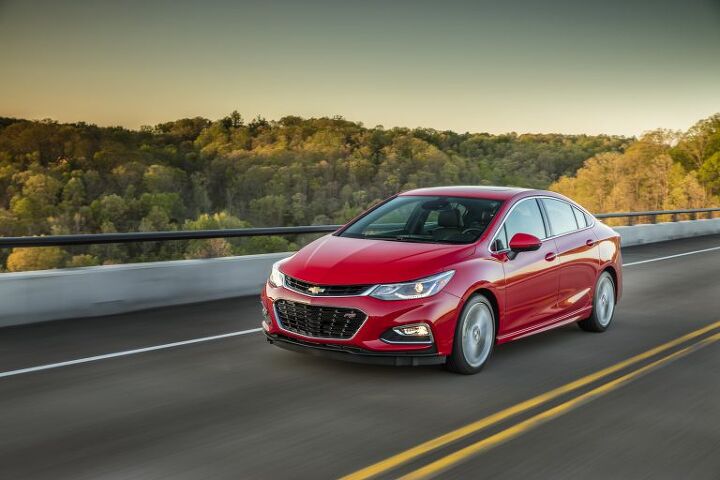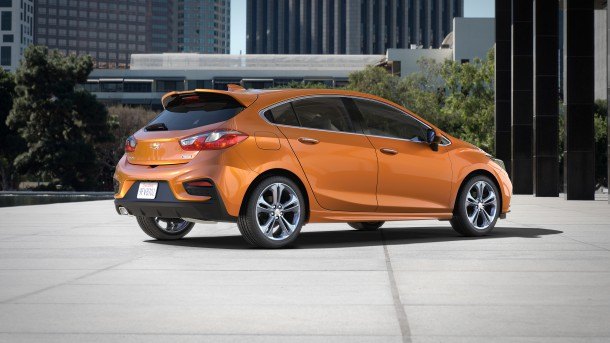GM Cuts Half of Lordstown Plant's Workforce as Chevrolet Cruze Sales Slide

General Motors summoned all 3,000 of its Lordstown Assembly employees to the Ohio plant this afternoon, and half left the meeting with an uncertain future.
The automaker said it plans to cut the second shift at the plant, just a year after GM scrapped the third shift in the face of declining compact car sales. Lordstown, which opened in 1966, builds only the Chevrolet Cruze.
The Youngstown, Ohio newspaper The Vindicator reports that the shift will end on June 15th, leaving 1,500 workers out of a job, though an attrition program offered by the automaker should see some of those workers enter retirement. WFMJ claims the retirement packages are worth $60,000.
Regular production, now on one shift, starts up again on June 18th. GM employs 2,700 hours workers at Lordstown, plus 300 salaried employees.
Congressman Tim Ryan (D-OH), who toured the plant in late March, was quick to issue a statement in the wake of the news. Ryan points the finger at President Trump and the Environmental Protection Agency’s new mandate to roll back fuel economy standards.
“I am deeply disappointed by today’s GM Lordstown announcement,” Ryan stated. “While low gas prices encourages the decline of compact car like the Chevy Cruze, President Trump’s intention to weaken fuel economy standards is putting his thumb on the scale in favor of the larger cars and SUV’s made elsewhere. He claimed he was against the government picking winners and losers, and yet he goes against the very region and state that helped put him in office.”
Corporate average fuel economy (CAFE) targets enacted by the Obama administration did little to stem the surge of buyers away from traditional passenger cars and into commodious trucks and SUVs. The law called for a fleetwide average of 54.5 miles per gallon by the target window of 2022 to 2025, something automakers increasingly rebelled against. EPA administrator Scott Pruitt has not yet stated what the new standard will be.
While overall light-duty vehicle fuel economy has stayed pretty much stagnant over the past few years, it does so with a far greater proportion of light trucks in the mix. Turbocharging, direct injection, multi-cog transmissions and CVTs, and hybrid drivetrains have allowed consumers to purchase a new, larger vehicle with the same fuel economy of a smaller car from a decade ago. That greatly increased the appeal of crossovers and SUVs, but it hasn’t done anything good for cars like the Cruze.
The Cruze launched at a very opportune time. As the economy bounced back from the recession, gas prices soared, making the compact sedan’s 2010 debut a perfect time to tempt car-seeking Americans with a domestic automobile boasting far greater build quality and fuel economy than previous small Chevys. Sales peaked at 273,060 units in 2014, declining each year since.
Sales of the Cruze, now available in hatchback form and with an optional diesel engine, sank 13.4 percent in March. Year-to-date, Cruze sales are off last year’s tally by 26.1 percent.
Last week, GM announced a refreshed 2019 model.
[Images: General Motors]

More by Steph Willems
Latest Car Reviews
Read moreLatest Product Reviews
Read moreRecent Comments
- Tassos OK Corey. I went and saw the photos again. Besides the fins, one thing I did not like on one of the models (I bet it was the 59) was the windshield, which looked bent (although I would bet its designer thought it was so cool at the time). Besides the too loud fins. The 58 was better.
- Spectator Lawfare in action, let’s see where this goes.
- Zerocred I highly recommend a Mini Cooper. They are fun to drive, very reliable, get great gas mileage, and everyone likes the way they look.Just as an aside I have one that I’d be willing to part with just as soon as I get the engine back in after its annual rebuild.
- NJRide Any new Infinitis in these plans? I feel like they might as well replace the QX50 with a Murano upgrade
- CaddyDaddy Start with a good vehicle (avoid anything FCA / European and most GM, they are all Junk). Buy from a private party which allows you to know the former owner. Have the vehicle checked out by a reputable mechanic. Go into the situation with the upper hand of the trade in value of the car. Have the ability to pay on the spot or at you bank immediately with cash or ability to draw on a loan. Millions of cars are out there, the one you are looking at is not a limited commodity. Dealers are a government protected monopoly that only add an unnecessary cost to those too intellectually lazy to do research for a good used car.



































Comments
Join the conversation
I'm a little surprised that sales are falling so much. Could it be the 2016 redesign causing the sales decline? I thought it was pretty decent... Year sales 2010 24,495 2011 231,732 2012 237,758 2013 248,224 2014 273,060 2015 226,602 2016 188,876 2017 184,751
What a darned waste. A great compact sedan. But how can Honda sell every Civic they can make, with minimal discounting? How can Toyota sell the stodgy Corolla in high numbers, with not much money on the hood? The Cruze was dying before Trump ever took office. The large SUV mutated into endless compact variations with comparable fuel economy to sedans. And people will keep buying SUVs even up to 4 buck gas. Higher fuel economy standards and gas taxes? It's all an elitist plot to maintain power. The elitists drive the desirable vehicles and the rest of us end up with donkey carts. You "save" the planet, but they OWN the planet. Maybe people would have more sympathy for higher fuel economy standards if if the Obamas and Hillarys drove Chevy Sparks instead of taxpayer-subsidized stretch limos. (Are you aware that HRC hasn't driven a car for decades b/c of that handy limo outside her door at all times?) I drive a 4cyl sedan with a stick. Not looking for any SUV. But I'll always want that choice and I don't need Obama telling me I can't have that choice. And by the way, Trump rocks!!!!!